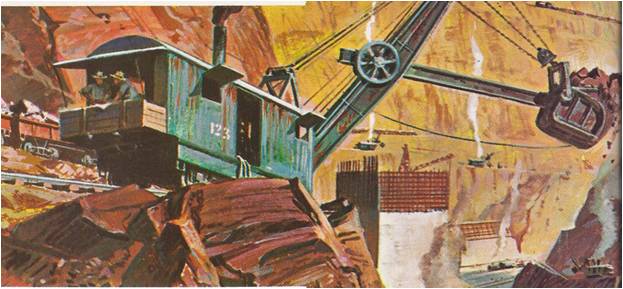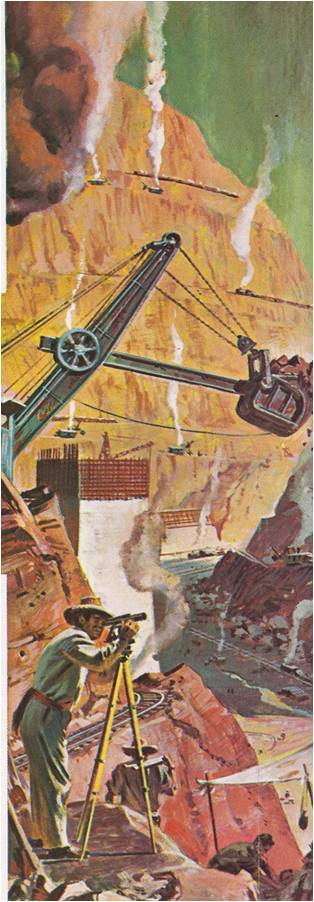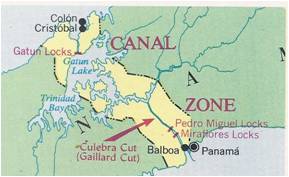THE UNITED STATES entered the race for colonies last of all the powers, at the end of the nineteenth century. Long before then, however, Americans were accustomed to taking over territory; they had, in fact, built their country westward from the Atlantic by settling lands they had bought or seized. In the Mexican War of 1845-48 they had taken a huge tract of land from Mexico by force.
Many Americans, including Abraham Lincoln believed that the Mexican War was simply an invasion of a weak country by its powerful, land hungry neighbour. Others maintained that the move was justified by the country’s needs. They pointed out that the United States was the largest, richest and most advanced nation in North America, with the fastest-growing population. For these reasons, they said, it was entitled to take the land it needed. This was the doctrine of “manifest destiny.” Its supporters believed that before long the United States was bound to dominate the continent, if not the entire hemisphere.
With the land it had gained in the Mexican War, the United States spanned North America from ocean to ocean. Talk of manifest destiny died down, for most Americans felt that the country had reached its limits. When Secretary of State, William Seward, bought Alaska from Russia in 1867, he was widely criticized. People said Alaska was nothing but a frozen wasteland and called it “Seward’s Icebox.” For a time they were too busy building up their own country to bother much about other lands.

By the 1890’s, however, the United States was a great industrial power and had trade links with several other parts of the world besides its old trading partners in Europe. Millions of American dollars were invested in neighbouring Latin American republics and American trade with the Far East, especially China, was growing. Americans began to look beyond their borders — south to Central and South America, and west across the Pacific. Like the western Europeans before them, they felt that they must have an empire.
From pulpits and platforms, in the halls of Congress and the editorial columns of newspapers arguments long familiar to Europeans were put forward. Imperialism was the mark of a modern industrial state. The United States must expand overseas, not only for the sake of its commercial and financial interests, but also to show the world that it was indeed a great and powerful nation. America, too, wanted its “place in the sun” and national pride demanded it.
Listening to such talk, many Americans felt uneasy. They reminded their countrymen that the United States had come into being by freeing itself from the British Empire; was it right for such a nation to impose its rule on others? Such objections were swept aside and in 1898, for the first time in its history, the United States took over territory outside North America. One such territory was the Hawaiian Islands, formerly the Sandwich Islands, in the mid-Pacific, four thousand miles from California. They had long been ruled by native kings, but in the nineteenth century, as whaling and trade developed in the Pacific, they came under the domination of, first, Britain and then the United States. After about 1875, real control was in the hands of American planters, who had large sugar and pineapple plantations on the islands and the American shipowners who transported their produce to the mainland.
In 1891, Queen Liliuokalani came to the throne. A woman of great spirit and energy, Liliuokalani wanted to rid the land of foreign influence and restore the old Hawaiian ways, but the American planters would not stand for this; they overthrew the queen, set up a republic and invited the United States to take over.

REMEMBER THE MAINE!
For several years the American government did nothing, not wishing to seem to approve of the planters’ strong-arm methods. In 1894 Japan showed its strength by attacking China and in the next few years other powers snatched more territory from the Manchu Empire. Finally, in 1898, the United States itself became a Pacific power by taking the Philippine Islands from Spain. In the same year, it “accepted its destiny” and annexed the Republic of Hawaii.

The old, half-forgotten doctrine of “manifest destiny” was thus revived in a new form. Fifty years before, the doctrine had been used to justify taking over sparsely settled neighbouring territory for one purpose — settlement. Now, it had been stretched to cover lands cut off from the United States by sea, lands which had large native populations and were sometimes unsuitable for settlement by anyone else. The doctrine had come to mean that the country had both a right and a duty to take over such lands — to keep them out of the hands of unfriendly powers, to make use of their natural resources, to educate and uplift their peoples. In its new form, manifest destiny had much in common with Kipling’s appeal to “take up the White Man’s burden.”
Of Spain’s once-vast empire in the Americas, all that remained was the large Caribbean island of Cuba and its smaller neighbour, Puerto Rico. For generations, the people of Cuba had periodically rebelled against their Spanish masters. Cuba lay only ninety miles from Florida and American businessmen had large sugar plantations there, many Americans knew of the islanders’ struggle and sided with them in their fight for Cuba Libre, a free Cuba.
When a Spanish general named Weyler arrived in Cuba in 1897 to put down the latest uprising, American newspapers rushed reporters and artists to the island. Day after day, they published illustrated stories, under hold, black headlines, telling of horrible cruelties indicted on the Cubans by the soldiers of “Butcher” Weyler. Throughout the country, sympathy for the Cubans and indignation against the Spaniards mounted.
Then, in February of 1898, the United States battleship Maine, on a visit to the Cuban capital, Havana, suddenly blew up in an explosion that killed more than 250 officers and men. The cause of the disaster was never discovered, but millions of Americans immediately blamed the Spanish authorities. Newspapers clamoured for war. In the streets of the cities, people waved American flags and chanted a new slogan:
Remember the Maine!
To hell with Spain!
While American and Spanish diplomats tried to preserve peace, war fever gripped both countries. In Congress, the war party grew louder and more numerous. At last, in April, President William McKinley gave in and signed the order which sent the country to war.
The United States easily defeated Spain. It quickly conquered Cuba, Puerto Rico and then — to the surprise of most Americans, who had never heard of it — a large group of islands called the Philippines, on the other side of the globe. By August the fighting was over. Puerto Rico and the Philippines were annexed outright, together with the small South Pacific island of Guam. Cuba became an independent republic. Since the United States kept the right to watch over Cuba’s relations with foreign countries and send troops there to restore order in matters of “life, property, individual liberty and Cuban independence,” it was really an American protectorate.
So, in the single year 1898, a country which had, itself been made up of colonies only a few generations before acquired a considerable overseas empire. Before the Americans could learn much about their richest new possession, the Philippines, a serious revolt broke out there. The Filipinos had expected to become free atlast, after four centuries of Spanish rule; that was why they had helped the Americans. When they found that they would now be under the rule of the United States, they took to the hills and began to raid American camps from jungle hideouts. The American soldiers found the task of combating them in the unfamiliar tropical countryside maddeningly slow and difficult After much bloodshed, the rebels were finally put down when their leader, “General” Aguinaldo, was captured in 1902. Americans were learning that imperialism was not all glory.
Even so, their new president, Theodore Roosevelt, urged them on. In the war with Spain, Roosevelt had fought in Cuba and as a mere assistant secretary of the Navy, he had ordered Admiral George Dewey to take Manila, the Philippine capital. As President from 1901 to 1909, he vigorously and enthusiastically promoted imperialism. Once, referring to a West African proverb, he declared that nations, like people, should “walk softly and carry a big stick.”
In 1904, Roosevelt warned the Latin American countries that “behavior which results in a general loosening of the ties of civilization may require intervention by some civilized nation.” The Monroe Doctrine, a keystone of American foreign policy since 1823, barred the European powers from meddling in the western hemisphere. Therefore, he concluded, the United States might be forced “to the exercise of an international police power.”
The next year, the island republic of Santo Domingo became bankrupt, to the alarm of its creditors in Europe. Before the European powers could take action, Roosevelt sent financial experts to Santo Domingo. They straightened out the country’s tangled finances and collected half of its customs in order to pay back the Europeans. In this way, he put into effect what came to be called the Roosevelt Corollary (or addition) to the Monroe Doctrine.
The Roosevelt Corollary supposedly gave the United States the right to intervene in the Western Hemisphere wherever, whenever and however it chose. From the first, proud Latin Americans bitterly resented this doctrine, particularly because of its insulting suggestion that the United States was “civilized” while they were not. The Cubans were just as resentful of the provisions in their constitution which gave the United States the right to intervene in their affairs. These provisions were called, after the American lawmaker who framed them, the Platt Amendment. For more than a generation, the Roosevelt Corollary and the Platt Amendment were to sow bad feeling for the United States in the lands to the south.
Under Roosevelt, the United States acquired a strip of land across the Isthmus of Panama, the narrow waist of the Americas, and at last began to build the canal between the Atlantic and the Pacific Oceans. As usual, the energetic and impulsive President personally took part in the proceedings.
Until 1904, Panama was only a small and poor province of Colombia, at the northwest corner of South America. The United States, eager to start digging the canal, offered Colombia ten million dollars for a site, but Colombia held out for more. Congressmen and other government leaders then proposed that the canal be built across Nicaragua, instead, but Roosevelt was determined to use the shorter, cheaper route across the isthmus.
A French company, originally headed by the creator of the Suez Canal, Ferdinand de Lesseps, had long before started to build a canal in Panama; it gave up the attempt when it ran out of money. The company wanted to be paid for its rights and its leftover equipment. One of its agents came to Washington where he talked to government leaders, including Roosevelt. Partly because of his efforts, Congress voted to build the canal in Panama rather than Nicaragua, but the Colombian government still said that the price offered for the land was too low.
At this, Roosevelt lost patience. He schemed with agents of the French canal company and other men to bring about a revolution in Panama. On the appointed day, a tiny band of hired soldiers and Panamanians seized the isthmus. American warships conveniently offshore, prevented Colombian troops from landing. The rebels proclaimed the independent republic of Panama. In the record time of two days, the United States recognized the new republic and received its ambassador — the French company’s agent.
A treaty was quickly drawn up and signed, granting Panama ten million dollars and $250,000 a year for a strip of land ten miles wide across the isthmus. Digging began and the Panama Canal was finally opened to inter-ocean traffic in 1914.
After the Canal Zone episode, the United States gave up imperialistic adventures. There followed, instead, a long period of “dollar diplomacy,” when the government at times sent soldiers and Marines into several foreign countries to protect its citizens’ investments. “Dollar diplomacy” and the Roosevelt Corollary showed the difference between the European and American brands of imperialism. European powers frankly took over countries where they had commercial interests and governed them as colonies. The United States, by contrast, preferred to leave such countries independent, even though the financial power of American bankers and businessmen gave it enormous influence over them.
While many Latin Americans disliked this American influence, they were at least spared the indignity of direct American rule. The time would come when the United States would repudiate the Platt Amendment and drop the offensive Roosevelt Corollary. “Dollar diplomacy” would be replaced by the “good neighbour policy,” putting the Latin American countries on a more equal footing with the “Yankee Colossus.”





